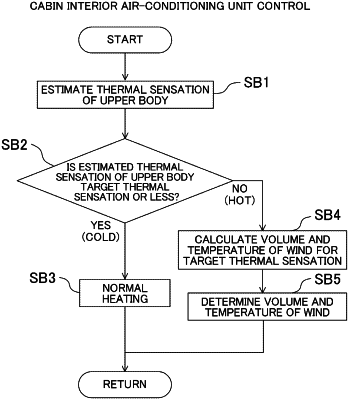| CPC B60H 1/00742 (2013.01) [B60H 1/00207 (2013.01); B60H 1/00285 (2013.01); B60H 1/00428 (2013.01); B60H 1/0075 (2013.01); B60H 1/00785 (2013.01); B60H 1/00878 (2013.01); B60H 1/2218 (2013.01); B60H 2001/00128 (2013.01); B60H 2001/00228 (2013.01)] | 12 Claims |

|
1. A vehicle heater including a cabin air-conditioning unit configured to produce air-conditioned wind blowing out of an outlet in a cabin and to condition air in the cabin using the air-conditioned wind, the vehicle heater comprising:
an auxiliary heater including at least one of a direct warmer positioned to correspond to a part of an occupant in contact therewith and configured to directly warm the occupant, or a radiant warmer positioned to be apart from the occupant and configured to warm the occupant by radiant heat;
a cabin condition detector, including at least a sensor, configured to sense or estimate at least one cabin condition of a temperature condition inside the cabin, a humidity condition inside the cabin, an airflow condition inside the cabin, or a solar radiation condition inside the cabin; and
a controller, including at least a processor and a memory, configured to:
detect operation states of the cabin air-conditioning unit and the auxiliary heater;
set target thermal sensations for a finite number of parts into which the occupant is virtually divided;
quantitatively estimate the thermal sensations of the respective parts of the occupant based on the cabin condition sensed or estimated, and the operation states of the cabin air-conditioning unit and the auxiliary heater detected; and
individually control the cabin air-conditioning unit and the auxiliary heater so that the thermal sensations of the respective parts estimated fall within a range of the target thermal sensations set, wherein
the parts include a near part to and a distal part from the outlet of the cabin air-conditioning unit, and
the controller is further configured to control a volume of air-conditioned wind delivered from the cabin air-conditioning unit in accordance with the thermal sensation of the distal part from the outlet, and control a temperature of the air-conditioned wind delivered from the cabin air-conditioning unit in accordance with the thermal sensation of the near part to the outlet.
|